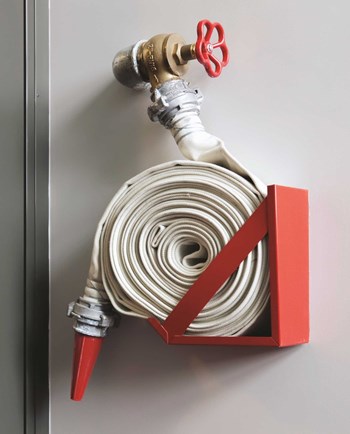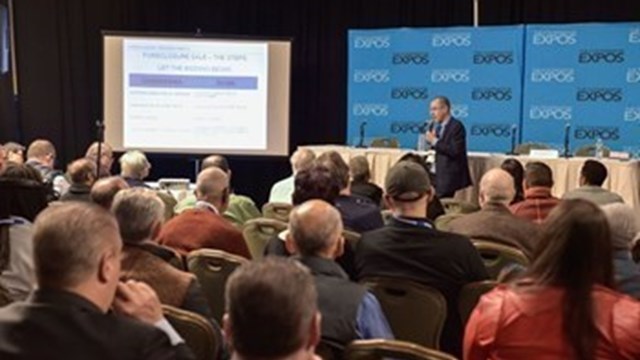
The discovery of fire is considered a major turning point in man's evolution from cave dweller to outer space explorer. Control of fire allowed early man warmth for his habitat, a way to cook his meals, and light for his surroundings. Fire also provided a means to frighten away predators and introduced a social element by bringing other humans together in a communal setting.
Harnessed and used for good, fire remains a wonderful tool for progress—but when out of control, flames are a deadly, devastating force. It is mankind’s best friend and fiercest enemy.
Fighting Fire...
The history of firefighting is probably as old as the element itself, but organized firefighting can be traced back to ancient Egypt where hand-operated pumps and bucket brigades were first employed to extinguish runaway flames.
Hand pumps and buckets were the state of the art in firefighting until 1672, when Dutch inventor Jan Van der Heiden invented the fire hose. Van der Heiden’s design was constructed of flexible leather coupled with brass fittings every 50 feet. The design was so perfect that the length and connections still remain the industry standard today.
The first fire engine appeared on the scene in 1725 and is attributed to Richard Newsham of London, England. Teams of men were employed to operate the manual pumps on specially designed horse-drawn carts when fire broke out. These early engines could deliver up to 160 gallons per minute at up to 120 feet in distance.
In this country, devastating fires in Jamestown and Boston inspired citizens to take greater measures towards combating fires. By 1648, Fire Wardens were appointed to patrol most cities—specifically to inspect chimneys, where most fires started. If fire was spotted during the night watches, the wardens would rouse the citizens to form bucket brigades. Wooden chimneys and thatched roofs were eventually outlawed, and heavy fines levied on non-compliant citizens.
The first volunteer fire company in America, the Union Fire Company was created by Benjamin Franklin in 1736 in Philadelphia. George Washington was also a volunteer firefighter with the Friendship Veterans Fire Engine Company in Alexandria, Virginia. In fact, Washington bought and donated Alexandria’s first fire engine.
By 1850, full-time firefighters were employed in most cities, but even after the formation of paid fire companies, there were disagreements and fights over territories. The early fire companies were paid by insurance companies, and turf wars between responding units were common. Government-run fire departments first appeared around the time of the Civil War. Today, fire and rescue is often a mix of full-time paid, paid-on-call, and volunteer responders. Most major cities are served by large, paid, well trained firefighting teams.
We Didn't Start the Fire...
If you ask any fire safety professional the best method for firefighting, you will get the same answer: Prevention! Preventing a fire is the best possible way to insure protection of life and property. Even a small fire can create a life-threatening emergency and expensive property damage. Destruction is not limited to the flames, either. Smoke and water damage, damage from elevated temperatures, toxic fumes, and additional—and unavoidable—destruction caused by firefighting practices themselves all contribute to the final toll. According to the pros, there is no such thing as an 'insignificant' fire. Multifamily units, apartments and condominiums present additional challenges for fighting fires, protecting lives, and containing flames and smoke. Awareness, education and pre-planning by residents and HOA boards can go a long way towards prevention of fires.
The majority of residential fires are a result of careless actions and habits of residents and often, completely avoidable. Fire experts consistently cite unattended cooking as the most frequent culprit. Often residents will leave the kitchen for a television show or phone call, giving frying, grilling and boiling pans to perfect opportunity to start a fire, according to Robert Morris, director of the fire prevention bureau at the Darien-Woodridge Fire District. “If you must leave the room, we encourage residents to carry a kitchen towel or spatula or anything else that reminds them that they have something going on in the kitchen,” he says. But that suggestion comes in second to his primary advice: if you need to leave the kitchen, even for a short while, just turn off the stove.
Other common causes of residential fires are space heaters overheating, children playing with matches and of course, smoking indoors. “So many people fall asleep with a cigarette in bed or lying on the couch, only to wake up to a room full of flames. For many years that is the number one cause of fire-related deaths,” says Morris.
Fire Prevention in Multifamily Buildings
Fortunately with careful actions and monitoring, most residential fires can be prevented. But fire prevention encompasses more than just turning off your stove or not throwing a lit cigarette in the trash; there are a few key practices that boards and residents should know and engage in.
Your first line of defense is fire alarms. “The first thing is to make sure there are ample and working fire alarms in your units so that should a fire occur, you have enough time to get out of the unit safely,” Morris says. He adds that ideally, smoke detectors and fire alarms should be checked on a monthly basis, both for battery life and usage.
Residents are responsible for the battery life for detectors inside their units and management needs to ensure that there are not only detectors inside the units fifteen feet from the doorways but also within the common hallways and on all levels, says Denis O'Halloran, fire chief at the Berwyn Fire Department.
Sprinkler systems, which are now a standard feature rather than an amenity in multifamily homes, are extremely valuable when it comes to fire prevention. “A fire sprinkler system protects lives and property by keeping fires small. Because the sprinkler system reacts so quickly, it can dramatically reduce the heat, flames, and smoke produced in a fire, allowing people more time to escape safely,” says Judy Comoletti, division manager of public education for the National Fire Protection Association (NFPA).
Morris adds, “We are very strong advocates of fire sprinkler systems and we would be remiss if we didn't say that they work 96 percent of the time.”
An important part of fire prevention also includes proper property maintenance. Faulty wiring, aging hot water heaters, and air conditioning units can all contribute to fire hazards. The life safety systems including smoke alarms, sprinklers, and exit lightning must also be maintained and checked on a regular basis.
Fire experts also note that it is imperative to keep all exits clear, so in the event of a fire, residents are not challenged with climbing over furniture, moving boxes or worst case, stuck behind doors or windows.
When developing a prevention/evacuation plan for the building, an excellent starting place for all boards would be with the local fire department. “They are the ones that would be dealing with your building, have intimate knowledge of any nuances that your building might have and can offer a lot of suggestions. They may say in some cases, you are better off to leave the building right away and in others it may be better to stay in your unit,” explains Morris.
In addition to your fire department, the Federal Emergency Management Agency (FEMA) and NFPA have guidelines on how to establish the best evacuation plan.
And remember, one plan isn't enough. Fire experts stress the importance of having at least two other evacuation options available in case your exits in Plan A become blocked or inaccessible.
If there are residents requiring special assistance in the event of fire or other emergency, it is imperative to have an evacuation plan in place ahead of time. “People who may not be able to escape on their own need to have a plan to assist in their safe evacuation and management should know who may need assistance,” says Comoletti. “Include those who need assistance to plan how best to accommodate them. They will be able to provide input on the best methods for them to escape.”
She suggests installing an evacuation chair that can assist individuals with a mobility disability and providing residents opportunity on how to use it. It is also important to consider residents with service animals, as they may need to have a special evacuation plan prepared for them. All circumstances that require special assistance can be discussed with your local fire department.
Once a board has a plan in place, sharing with the residents is imperative. “I would do this in a couple different directions. I would have that plan on paper and make sure that the association and the fire department were in agreement. I would distribute it to each unit and from there, address it through newsletters and open meetings,” Morris says.
Then, it's practice, practice, practice. Simply being aware of a plan won't help you in a fire, when emotions and anxiety are running high. Holding monthly or quarterly “fire drills” for your building can help residents identify exits and meeting areas first hand and learn how to escape quickly, should a real fire take place.
In Case of Fire
In the event of a fire, it is imperative that residents remain calm and try to identify the best and quickest exit strategy. “You need to investigate the situation and get out should there be a fire,” Morris says.
Another important tip for residents to remember is to feel the unit door before opening it to the common hallway. If the door is cool to the touch, the door may be opened slowly; if there is smoke present in the hallway the door should be closed immediately. A wet bath towel may be placed firmly along the inside of the door, and the fire department should be called immediately. A resident may then open a window and have a towel or scarf to signal the location of the unit and alert the fire and rescue team.
If the door is cool to the touch and there is no smoke a resident may move quickly but safely to the designated fire exit. Morris urges residents to close doors to the unit in order to keep the fire from spreading from one unit to another. Leaving a door open allows fire and smoke to travel much quicker and can obstruct a potential exit for another resident, he says.
It may be necessary to crawl or stay low, and visibility may be limited if smoke is encountered. A damp towel is excellent to protect your nose and mouth in the event of smoke. Any fire alarm box encountered along the exit route should be activated, to further alert both residents and rescue team members.
The evacuation plan should include a communal meeting place so that all family members and pets can be accounted for. “This allows you and us to see that everyone is out and determine if anyone is still inside or missing,” says O'Halloran.
The level of community involvement desired in the planning and preparation for emergency action will ultimately be a board decision. However, once those plans are in place all residents should be made aware of the details by the accepted method of community communication and updates and reviews should occur on a regular basis in order to ensure the health, safety and peace of mind of both residents and board members.
Anne Childers is a freelance writer and a frequent contributor to The Chicagoland Cooperator. Editorial Assistant Maggie Puniewska contributed to this article.




Leave a Comment